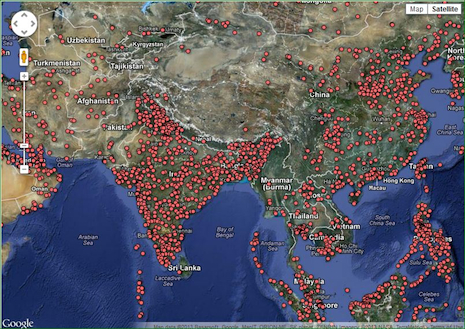Citizen Scientists to Help Map Global CO2 Emissions
Climate science researchers from Arizona State University are launching an innovative online "game" to better understand the global carbon cycle.
 Across the globe, there are approximately 30,000 power plants that burn fossil fuels for energy. All together, these sites are responsible for 40 percent of the global carbon dioxide (CO2) emissions that go into the earth's atmosphere each year. Despite this hefty environmental impact, an accurate, comprehensive listing does not exist. At least not yet.
Across the globe, there are approximately 30,000 power plants that burn fossil fuels for energy. All together, these sites are responsible for 40 percent of the global carbon dioxide (CO2) emissions that go into the earth's atmosphere each year. Despite this hefty environmental impact, an accurate, comprehensive listing does not exist. At least not yet.
A new project from Arizona State University is leveraging the power of crowds to locate all the power plants around the world using a simple Google Maps interface. The ambitious endeavor, called Ventus, seeks to map each power plant's location and carbon dioxide emissions.
Latin for "wind," Ventus is the brainchild of Kevin Gurney, an associate professor in ASU's School of Life Sciences in the College of Liberal Arts and Sciences. As lead scientist for the project, he believes it will lead to a better understanding of the sources of global warming gases.
"Of all the fossil fuel CO2 emissions in the world, power plants account for almost half – so a pretty big portion of the climate change problem is due to the production of electricity everywhere in the world," said Gurney, who is also a senior scientist with ASU's Global Institute of Sustainability. "While you might imagine that we would know where they are and how much they're emitting, it turns out we don't. With the growth in countries such as China, India and Brazil, this lack of information is poses challenges for both basic science and climate change solutions."

Participants are welcome to enter basic information about power plants, such as a site's location (within a few hundred meters), the type of fuel used, the amount of electricity produced, and the amount of CO2 emissions. Users are free to contribute as little or as much information as they can. They are also invited to correct the information that others have submitted.
"Our logic is that for every power plant in the world, there are probably at least a dozen people who live near it, work at it, or know someone who works at it. With the proliferation of phones and GPS, it makes it pretty easy to locate things," states Darragh O'Keefe, the ASU research scientist who built the website. To encourage participation around the world, the Ventus website will be available in several languages.
Ventus officially launched today. Registered users will receive a point for each piece of information and he player who provides greatest amount of usable information at the end of the first year will be awarded with a trophy and be included as an author on a research publication. According to the project website, this new Supreme Power Plant Emissions GURU "will be famous among our very elite, newly formed global group of citizen scientist enviro-nerds."










